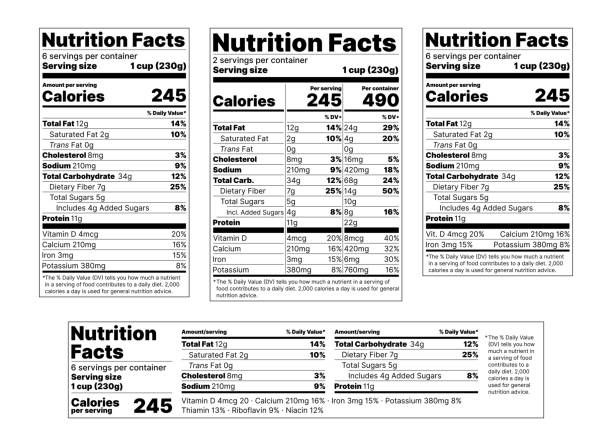What do all these ingredients on food labels really mean?
- Tips From Pips

- Feb 24, 2023
- 3 min read
Updated: Aug 19, 2024

What do all those food label ingredients mean? Are they good for you?
Part 2 - Reading Food labels on products is knowing exactly what the ingredients are. Are they good or bad for your body on your health happiness journey?
Here is a breakdown of what I have learned:
If it is a super long name, that you cannot even pronounce -it’s most likely not good for you!
Certified Organic: Right now, the most meaningful label on your food, in terms of upholding specific government requirements, is the U.S. Department of Agriculture (USDA) Organic seal. For a product to be certified organic, it’s required to meet specific standards:
Organic crops cannot be grown with synthetic fertilizers, synthetic pesticides, or sewage sludge.
Organic crops cannot be genetically engineered or irradiated.
Animals must eat only organically grown feed (without animal byproducts) and can’t be treated with synthetic hormones or antibiotics.
Animals must have access to the outdoors, and ruminants (like cows) must have access to pasture.
Animals cannot be cloned.
What is GMO?
Genetically modified organisms (GMOs) can be defined as organisms (i.e., plants, animals, or microorganisms) in which the genetic material (DNA) has been altered in a way that does not occur naturally by mating and/or natural recombination.
What does GMO do to the body?
The results of most studies with GM foods indicate that they may cause some common toxic effects such as hepatic, pancreatic, renal, or reproductive effects and may alter the hematological, biochemical, and immunologic parameters.
Why should I avoid GMOs?
Use of GMOs eventually requires stronger pesticides and herbicides to be used in food production, leading to the depletion of trace minerals and the destruction of critical soil microbes crucial to human health.
O.K. enough about GMO’s on to the next ingredients to watch out for:
Preservatives – what are these? What are the most harmful preservatives?

Here's a list of 7 Food Additives and Preservatives to Avoid:
TRANS FATS.
SODIUM NITRITE.
MONOSODIUM GLUTAMATE (MSG)
ARTIFICIAL FOOD COLORING.
HIGH FRUCTOSE CORN SYRUP.
ASPARTAME.
BHA & BHT.
What are “Natural Flavors”?
Don’t let the term fool you! It is just another word to fool you into thinking they are good whole-some flavors, when in reality they are “artificial flavors”.
Natural flavors are found in a variety of packaged food and beverage products.
Natural flavors may contain artificial chemicals and are not always better for you than artificial flavoring.
It is always best for most foods you eat to come from whole, minimally processed sources.
Misleading Food Labels:

Free Range “Free range” labels are regulated by the USDA only for poultry produced for meat – it’s not regulated for pigs, cattle, or egg-producing chickens. Nor are the requirements very high. Poultry can use the label if the chicken had any access to the outdoors each day for some unspecified period of time; it could be just a few minutes, and does not assure that the animal ever actually went outdoors to roam freely.
Natural and Naturally Raised According to USDA, “natural” meat and poultry products cannot contain artificial colors, flavors, or preservatives, and they should be “minimally processed.” However, this label does not tell us how the animals were raised, what they were fed, if antibiotics or hormones were used, or other aspects of production that consumers might logically expect from something labeled “natural.”
For all other foods (milk, eggs, and non-animal food products), the “natural” label is virtually meaningless.
Fresh Contrary to what you might expect, the label “fresh” is used only on poultry to indicate that the meat was not cooled below 26 degrees F. Poultry does not have to be labeled as “frozen” until it reaches zero degrees F. This can be misleading to customers who assume that label means meat has not been frozen, processed or preserved in any way. The USDA does not define or regulate the use of the “fresh” label on any other type of products.

Pasture Raised “Pasture-raised” or “pastured” means that animals spent at least some time outdoors on pasture, feeding on grass or forage. However, there are no government standards for this label, including how much of its life the animal spent on pasture.
This blog post is just the tip of the iceberg on what to watch out for on your food labels!. I only covered a few things that I have gained knowledge from.
There are so many artificial flavors and artificial ingredients in processed food items. Too many to list here!

My best advice – stay away from as many processed foods as you can! The more you know the better your health happiness journey! Want a healthy gut? Eat wholesome, all natural ingredients!
The more knowledge you know and change into your good habits, the more you will become a happier, healthier person and live a long fulfilling life!
Be the change you want to be!







Comments